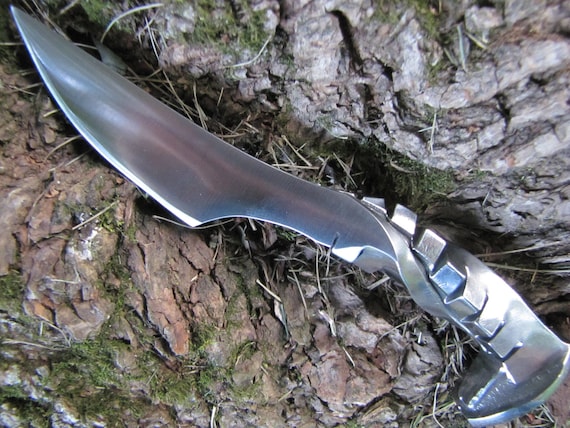I have numerous rail spikes that I was hoping I could bring to you to heat and pound the ends into steak knives and or cheese knives?
Short answer - no
see : http://www.cartercrafts.com/carbon_myth.htm
The problem with rail spikes as a starting material is that the highest carbon content available is only 1030.
Regular mild steel is usually 1020
For a machette, you might use 1045
The second number of those specifications is 1/100 of percent carbon. Any knife expected to hold a decent working edge should be at least the range .5 % (1050), but ideally closer to .7 to 1 % carbon.
This refers directly to what I at least call 'the Bladesmith's Dilemma' :
As you increase * hardness * (via more carbon), you also increase * brittleness *.
Compare a typical machette at about 0.50 % carbon. You can hack down a tree with it, but it does not stay sharp all that long.
With a box cutter, which is razor sharp, but breaks with the least amount of force to it.
The amount of raw material on a rail spike will limit the finished cutting edge to something in the range of 4 - 6 inches. At that size limit, normally use of a higher carbon range is indicated.
Do also remember that you can make a piece of paper 'sharp' enough to cut your finger. The question should not be 'how sharp is it?' (a function of care with polishing). More important is 'how long will it *keep* that edge?'.
I personally consider making knives from rail spikes as a kind of a beginner's trick.
Go and search Google Images : 'railroad spike knife' ...
| 'Typical' rail spike knife - here by Salem Straub (shows as #2 on search) |
If you also take a fast look on etsy - the average price for the 'standard' designs seems to start about $50 and maybe to $75 each (US).
Mind you there are some nice looking examples showing in the general search :
 |
| ...by RplRaven / Robert Lindsay (shows as #10 on search) ... by Mainline Steel Works / E. Sievers (?) (shows as #19 on search) |
As far as you can tell from a photo on Etsy - those both look like very nice pieces, in terms of design, forge work and finishing. (And both have sold btw.)
Another thing to consider : New or Used material?
All these makers stressed in their description these were HC marked spikes. Even at a 'low medium' carbon content, a *used* rail spike has been subjected to stress in its normal working life.
• The process of hammering it down into a hardwood (typically oak) rail tie does involve in the application of considerable force as it is driven in *. This may produce shearing force to the area joining head to body of the spike.
• The purpose of a rail spike is to secure a section of rail track. Which is repeatedly pounded by passing trains. Certainly this must produce considerable shock / stress into the same area (joint of head to shaft. The body of the spike would certainly be cushioned by the surrounding wooden tie. Of course this is the part of the metal spike being forged into the blade itself.
It does make me wonder why anyone would put so much time and effort - into what is an inferior material??
Taken all together, the only reason I can envision for using a rail spike as starting material for a blade may be the knob of the original spike's head. If you like that kind of thing. (I don't.)
Or more likely - it is because rail spikes are easily picked up along the tracks for free.
This may be a consideration for the cheapest / simplest (usually also least skill employed) versions. The more elaborate (higher skill and attention to detail) versions run into the $100 - $200 (US) range however. At that price, 'saving' the small price of brand tool steel bar stock, (at roughly $3 - $5) honestly just does not make any sense.
Do check my general information on custom bladesmithing:
http://www.warehamforge.ca/knife.html
* Believe me! I worked one summer in my early summer building rail track switches for Canadian Pacific RR out of Thunder Bay. Handling a specially designed spike driving hammer is trickier than it may look - especially when seen in the (skilled!) hands of someone who does it all day, every day. A slight shift in aim puts the striking force to one edge of the semi-spherical shaped head. This produces sideways force (and shock) to that 'hard' metal.

















